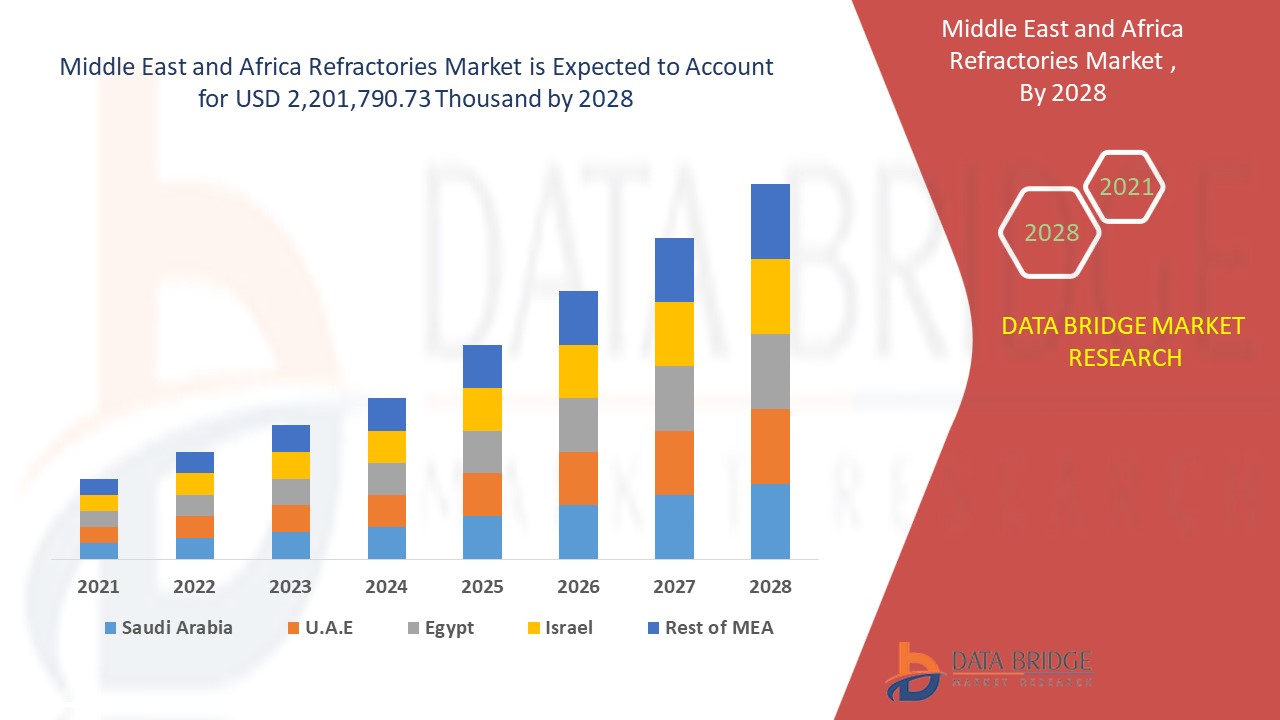Middle East and Africa Refractories Market Research Report | Growth, Trends and Advancements | 2025 - 2032
Data Bridge Market Research analyses that the market is growing at a CAGR of 3.4% in the forecast period of 2021 to 2028 and expected to reach USD 2,201,790.73 thousand by 2028.
Introduction
The Middle East and Africa (MEA) region is witnessing dynamic industrial growth, with rapid advancements in steel, cement, non-ferrous metals, and related sectors. This industrial momentum fuels increasing demand for refractory materials—specialized heat-resistant materials essential for high-temperature processes. Refractories serve as critical protective linings for equipment such as furnaces, kilns, and reactors, ensuring operational safety and efficiency. This report presents a detailed analysis of the MEA refractories market, focusing on market size, segmentation, regional dynamics, trends, challenges, and future prospects. Understanding these aspects is vital for stakeholders aiming to navigate and capitalize on opportunities in this evolving industrial landscape.
Middle East and Africa Refractories Market Overview
The Middle East and Africa (MEA) refractories market plays a crucial role in supporting the region’s industrial infrastructure, particularly in thermal-intensive sectors such as steel, cement, and non-ferrous metals production. As regional economies continue to invest heavily in industrial development and infrastructure projects, the demand for durable and high-performance refractory materials has witnessed a steady rise. These materials are designed to withstand extreme heat and corrosive environments, making them indispensable in high-temperature operations crucial for the region’s industrial growth. This article provides an in-depth analysis of the MEA refractories market, highlighting key trends, market segmentation, industry drivers, challenges, and future outlook.
The MEA refractories market was valued at over USD 1.6 billion in 2024, with demand expected to grow in alignment with ongoing industrial expansion mainly across Saudi Arabia, the United Arab Emirates (UAE), and South Africa. The market is composed of a broad range of refractory products, including bricks, monolithic refractories, and fibers. These products vary by chemical composition—acidic, basic, and neutral—and by their fusion temperature classification, supporting various industrial processes. The dominance of basic refractories in the region reflects the alkaline nature of many metallurgical applications prevalent in the MEA.
Market Segmentation
Refractory materials in the MEA region are segmented primarily based on their chemical nature and physical form:
-
Basic Refractories: Commonly composed of magnesite and dolomite, these refractory materials are widely used for steelmaking and cement production due to their resilience in highly alkaline and corrosive environments.
-
Acidic and Neutral Refractories: Utilized in processes that require resistance to acidic slags, glass manufacturing, and some non-ferrous metal applications.
Regarding product types, refractory bricks remain the preferred option for many furnace linings, while monolithic refractories are gaining popularity for their versatility and ease of application. The application of super refractories, which operate in extremely high-temperature environments, is limited but significant in select industrial processes.
End-Use Industry Dynamics
The refractories market in the MEA region is predominantly driven by the iron and steel industry, which accounts for a majority share of the demand. Steel plants rely heavily on refractory linings for furnaces, ladles, and casting machines to ensure efficient and safe production. The expansion of electric arc furnaces and direct reduced iron plants is particularly influential in shaping refractory demand.
Additionally, cement production is a major consumer of refractory materials. The ongoing surge in construction and infrastructure projects throughout MEA countries fuels demand for durable kiln linings. Industries such as glass manufacturing, non-ferrous metal processing, and chemicals, though smaller in scale, also contribute to overall consumption.
Regional Market Insights
Saudi Arabia leads the regional refractory market, thanks to its robust steel industry and government initiatives supporting domestic industrial growth. The UAE, with its diverse industrial base including steel and aluminum sectors, maintains a steady demand for high-grade refractories. In Africa, South Africa stands out due to its well-established mining and metallurgical industries. Other countries like Egypt, Nigeria, and Israel contribute to regional growth, though to varying extents, reflecting different industrial capacities.
Market Trends and Drivers
Industrial growth and capacity expansions across steel, cement, and metallurgical sectors remain the fundamental drivers of refractory demand. Governments in the region are prioritizing economic diversification and infrastructure investments, boosting industrial activity.
Another significant trend is the increasing focus on local refractory production to mitigate supply chain risks highlighted during recent global disruptions. This shift helps stabilize material availability and supports regional industries.
Technological advancements improve refractory formulations, emphasizing enhanced thermal and chemical resistance. Digital monitoring and automation of refractory applications enhance operational efficiency and reduce maintenance downtime.
Environmental awareness is rising, leading to the adoption of eco-friendly refractory materials and recycling practices. The industry is gradually progressing toward sustainability goals aligned with global standards.
Challenges
The MEA refractories market faces challenges with raw material price volatility, particularly for key inputs like bauxite and magnesite. These fluctuations affect cost structures and procurement strategies.
Refractory demand also follows the cyclical nature of the steel and cement industries, causing periodic fluctuations aligned with economic conditions and production cycles.
Competition from imports and variable industrial development across countries limit the uniform growth and export potential of locally produced refractories.
Future Outlook
Looking forward, the MEA refractories market is expected to sustain steady growth linked with ongoing industrial expansion and infrastructure projects. The continuous addition of new steelmaking and cement production capacities will further stimulate demand. Advances in refractory technology and increased local manufacturing capabilities will enhance market resilience and value creation. Environmental and sustainability considerations will increasingly shape product development and industrial practices. Success in this market will depend on aligning with regional industrial strategies, supply chain robustness, and innovation adoption.
Conclusion
The Middle East and Africa refractories market stands at a critical juncture, driven by robust industrial growth and ambitious infrastructure projects. As the steel, cement, and metallurgical industries expand, refractory materials remain indispensable for maintaining operational efficiency and safety in high-temperature industrial processes. Increasing localization of production, technological innovations, and a growing emphasis on sustainability will continue to shape the market’s trajectory. However, challenges such as raw material price volatility and market cyclicality necessitate strategic planning. Overall, the market holds significant potential for stakeholders willing to adapt to evolving dynamics and invest in advanced and sustainable refractory solutions.
Frequently Asked Questions (FAQs)
What are refractories and why are they important in the Middle East and Africa?
Which industries drive demand for refractories in the MEA market?
What is the current market size and growth outlook for the MEA refractories market?
How is local production impacting the refractories market in the region?
What technological advancements are shaping the MEA refractories market?
What are the main challenges faced by the refractories industry in the Middle East and Africa?
Equip yourself with actionable insights and trends from our complete Middle East and Africa Refractories Market analysis. Download now:https://www.databridgemarketresearch.com/reports/middle-east-and-africa-refractories-market
Browse More Reports:
Global Fluid Loss Additives Market
Global Food And Beverages Color Fixing Agents Market
Global Freezers Market
Global Function-as-a Service Market
Global Genetic Engineering Plant Genomics Market
Global Glucagon-Like Peptide 1 (GLP-1) Agonists Market
Global Green Fluorescent Protein Market
Global Healthcare Education Solutions Market
Global Healthcare Nutrition Market
Global Health Screening Market
Global Heart Valve Disease Treatment Market
Global Hemodialysis Vascular Grafts Market
Global Hot Stamping Body in White Market
Global Hydroponics System Market
Global Hyperacusis Drug Market
About Data Bridge Market Research:
An absolute way to forecast what the future holds is to comprehend the trend today!
Data Bridge Market Research set forth itself as an unconventional and neoteric market research and consulting firm with an unparalleled level of resilience and integrated approaches. We are determined to unearth the best market opportunities and foster efficient information for your business to thrive in the market. Data Bridge endeavors to provide appropriate solutions to the complex business challenges and initiates an effortless decision-making process. Data Bridge is an aftermath of sheer wisdom and experience which was formulated and framed in the year 2015 in Pune.
Contact Us:
Data Bridge Market Research
US: +1 614 591 3140
UK: +44 845 154 9652
APAC : +653 1251 976
Email:- corporatesales@databridgemarketresearch.com
- Art
- Causes
- Crafts
- Dance
- Drinks
- Film
- Fitness
- Food
- الألعاب
- Gardening
- Health
- الرئيسية
- Literature
- Music
- Networking
- أخرى
- Party
- Religion
- Shopping
- Sports
- Theater
- Wellness


